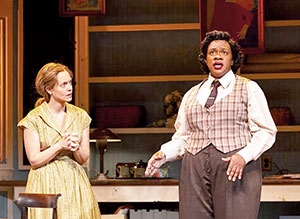 *
*
Review by Andy Hoffman
In Joy and Pandemic, a world premiere at the Calderwood Pavilion of the Huntington Theater, playwright Taylor Mac locates the conflict between belief and reality in a children’s art school in 1918 Philadelphia. Joy, the founder of the school, believes devoutly in Christian Science, which will run head first into the bursting Spanish Flu pandemic, which will kill over 50 million people as troops returned home from the last battles of World War I. This apocalyptic moment tried whole nations’ faith in social hierarchies, in political solutions, and in moral values, but it fails to shake Joy’s belief in the religion founded by Boston’s own Mary Baker Eddy.

Joy and Pandemic
A play by Taylor Mac
At The Calderwood Pavilion/Huntington Theater through May 21, 2023
Played out in the storefront location of Joy’s school on the day of the school’s open house, Joy and Pandemic takes a ride on the narrow rail between realism and philosophy. In the first act, we meet Joy and her teenaged daughter Pilly. After the disappearance of Pilly’s father, Joy has married Bradford, a wastrel and artist who came from a wealthy family. We also meet Bradford’s mother, who has funded the school in a last-ditch effort to save Bradford from a completely wasted life.
Joy believes, as Christian Science prescribes, that illness, pain, and our human manifestation is simply an illusion, a test of our faith. If we believe fully, we will transcend that plane of reality and achieve our oneness with the perfect divine. Neither Bradford nor his mother embrace this notion, but they can see that the energy Joy’s faith gives her imbues the school and gets passed along to the students as represented in five-year-old Marjory. While we don’t meet the child, we see her painting, a wildly passionate abstract, and we meet her mother, Melanie, who comes to the open house early.
Melanie comes out of concern for Marjory’s safety, as she has good reason to distrust Bradford. Also, Melanie’s skin color – Marjory is the only Black student in the school – gives her extra caution in dealing with the white world. Through the storefront windows, we see the start of a parade, tinsel confetti fluttering to the ground. This piece of history – Philadelphia allowed a parade as the 1918 pandemic killed millions – files the conflict between fact and belief to a fine and cutting point. Both Melanie and Joy fall ill. We find out what becomes of them in the play’s last act, after the intermission. We jump ahead to 1952. Joy and Pilly remain in the storefront, living their lives in plain sight, as Marjory points out to Pilly.
Joy and Pandemic offers insights into our contemporary pandemic and the social changes we have experienced, but always in a sidelong glance. Taylor Mac – a MacArthur award and Ibsen Prize winner – has constructed a fascinating feast of ideas and emotions, refusing us answers, as the best drama always does.
At the same time, as a world premiere, the play comes across as a bit unfinished and muddled. This always happens: plays must be performed to find their strengths and weaknesses. The strengths of this production are clear: excellent performances, a lovely and flexible set, and a well-built structure that poses questions that keep us guessing until the end. We receive revelations about what we owe our parents when mothers and daughters Melanie/Marjory and Joy/Pilly are played by the same actresses, now 34 years later.
The weaknesses are more subtle. Bradford’s mother provides too much exposition in the first act and Pilly does the same in the third act. The vaudevillian touches lighten the tone but add little to the show as a whole. And we don’t realize until after the intermission that Melanie’s and Marjory’s race actually matters; it seemed throughout the first and second acts that the play had been cast race-blind, when there were plenty of opportunities to make it clear that we were watching America at its Jim Crow peak.
All of these flaws can be fixed during this run or before the play gets its future productions. It is well worth seeing this excellent play by a significant figure in American theater in its earliest stages. Applause to the Huntington for working with Taylor Mac on this premiere.















Reader Comments